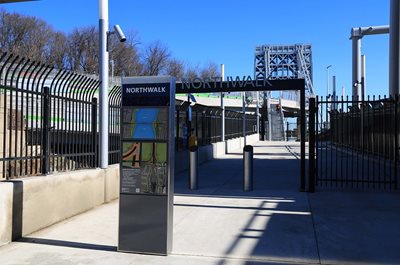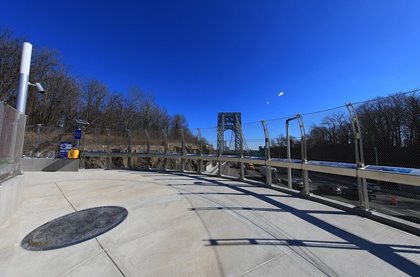For the first time in the 100-year history of the world’s busiest bridge, pedestrians and cyclists can connect from sidewalks on the New York and New Jersey sides of the Hudson River directly to the George Washington Bridge. Bicyclists no longer have to carry their bikes up stairs but instead can enjoy plazas and viewing platforms on either end, protected by bollards and pylons.
The changes are part of pedestrian and cyclist access improvements, which Alexander Levi, a principal architect in the Design Division of the Engineering Department at the Port Authority of New York and New Jersey, outlined in a presentation to the NJTPA Board of Trustees during its September 12 meeting.
Jay Shuffield, who represents the Port Authority on the NJTPA Board, said the bridge is a significant goods movement corridor, but it’s also the only direct Hudson River crossing for pedestrians and cyclists. The $2 billion to rehabilitate the bridge is funded entirely by Port Authority revenue, as toll roads are ineligible for federal funding, he said.

Levi said the bridge has never had an accessible way for people on bike or foot to cross the span. Othmar Ammann, the original engineer, designed a sidewalk that went from anchorage to anchorage but did not connect back on both sides to the respective approaches. The bicycle and pedestrian improvements are part of a larger rehabilitation project called Restore the George.
“The multi-year effort to ‘Restore the George’ gave us the opportunity to not only replace the suspender ropes, check the main cables, and do a whole bunch of upgrades, but finally consider accessibility across the bridge for people making their way across without a car,” Levi said.
Photo Credits: Port Authority NY NJ
Work on the North Walk began in 2017 and was recently completed. Long switchback ramps 11 to 14 feet wide were installed to provide access, eliminating the need for cyclists to navigate stairs and hairpin turns. The New Jersey ramp connects to the Long Path in Palisades Interstate Park in Fort Lee and there is also a viewing area.
The North Walk opened in February and has seen “incredible volume” even during the week. “It’s not just a leisure bridge, it’s become more than ever a commuting connection between the two sides,” Levi said.
The southern side of the bridge is now closed to pedestrians and cyclists. The new South Walk is expected to open in 2027. Once both sides are complete, there are plans for the North Walk to be used exclusively by cyclists and for the South Walk to be for pedestrians and people in wheelchairs, Levi said.
In addition to the new access ramps, platforms were built around the bridge towers to eliminate successive 90-degree turns and instead allow for more visual distance. “There’s a suggestion of a shared use environment and approach,” he said. “You see other people coming and you respect and monitor the distance as you head toward them.”

Specifically on the Fort Lee side, the project integrated an entire upgrade of the biking infrastructure along Hudson Terrace, including a bidirectional bike path and intersection upgrades to improve safety for pedestrians and cyclists. “For the first time in my memory as a cyclist, you can come down from your 50- to 100-mile ride and actually cross safely onto the bike path, with an actual light that is made for your turn onto this plaza,” Levi said.
Previously, there was no space for cyclists to meet as they waited to travel north along the Palisades, so they gathered dangerously along the streets. Now, there is an entry plaza on both the New York and New Jersey side, with bollards and pylons and a gate for a sense of placemaking.
The NJTPA also is coordinating with the New York Metropolitan Transportation Council on a feasibility study of a separated walking-biking path along the Palisades Interstate Parkway and U.S. 9W corridor connecting the George Washington Bridge to the Governor Mario M. Cuomo Bridge, formerly the Tappan Zee Bridge, which also has upgraded walking and biking facilities.
Levi described it as an unprecedented moment in the GWB’s history to “connect its original sidewalks to its respective communities that it serves.”
He noted that the project also includes an educational component. “You also get to celebrate and understand and learn about the bridge in a way that you hadn’t before, with interpretive displays and places to rest and look at the towers.”